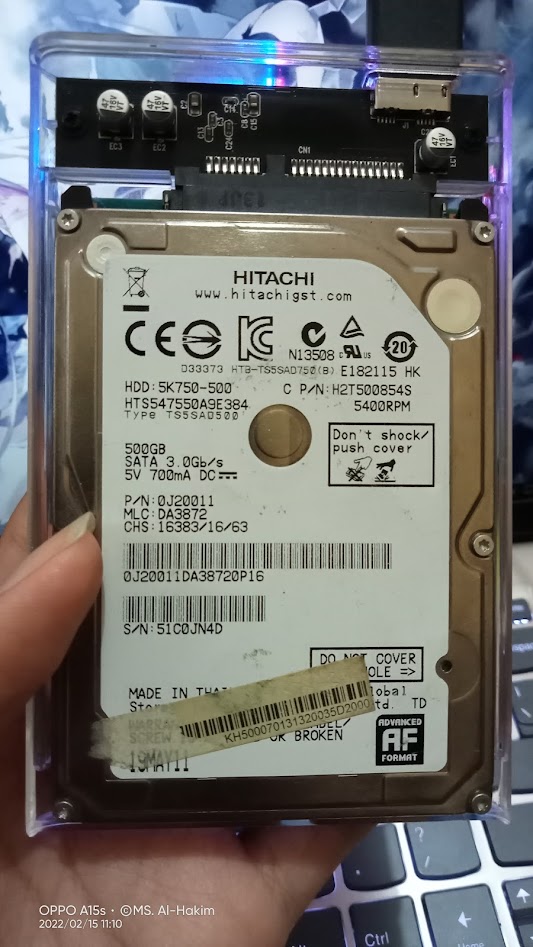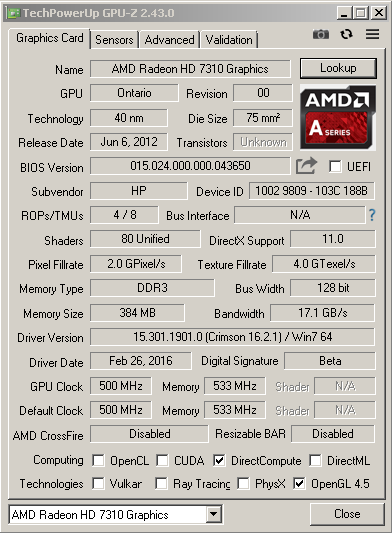Comparing: AMD Radeon HD 7310 IGPU VRAM Disk vs Hitachi HTS547550A9E384
In this comparison, we analyze two Disks: AMD Radeon HD 7310 IGPU VRAM Disk and Hitachi HTS547550A9E384, using synthetic benchmark tests to evaluate their overall performance. This side-by-side comparison helps users understand which hardware delivers better value, speed, and efficiency based on standardized testing. Whether you're building a new system or upgrading an existing one, this benchmark-driven evaluation offers valuable insights to guide your decision.

AMD Radeon HD 7310 IGPU VRAM Disk
| Type: | Disks |
|---|---|
| Model: | Radeon HD 7310 IGPU VRAM Disk |
| Capacity: | 128MB |
| Interface: | DDR3 |

Hitachi HTS547550A9E384
| Type: | Disks |
|---|---|
| Model: | Hitachi HTS547550A9E384 |
| Capacity: | 500GB |
| Interface: | SATA-II 3Gbps |
Specification Comparison Table
This specification comparison presents technical details of several devices or components to help you understand the key differences between each option. Use this table as a reference to determine which device best suits your needs.
| Specification | AMD Radeon HD 7310 IGPU VRAM Disk | Hitachi HTS547550A9E384 |
|---|---|---|
| Brand | - | Hitachi |
| Format | VRAM Disk | HDD 2.5 |
| Capacity | 128MB | 500GB |
| Interface | DDR3 | SATA-II 3Gbps |
Submission Comparison Table
This submission comparison table displays the number and details of benchmark data submissions from various devices or components. This information helps you understand the performance based on the benchmarks that have been tested, as well as providing an overview of the consistency and popularity of the available benchmark results.
| No. | Benchmark Software | AMD Radeon HD 7310 IGPU VRAM Disk | Hitachi HTS547550A9E384 |
|---|---|---|---|
| 1 | CrystalDiskMark |
Read: 393.23 MB/s Write: 393.66 MB/s |
Read: 88.66 MB/s Write: 88.06 MB/s |
Submission Comparison Chart
This chart visualizes the benchmark scores comparison between two hardware devices based on submitted data.
Media Gallery
A collection of photos of tested hardware. These images can help you identify the physical form, model, and variant of the hardware in question. These photos are from our own documentation, and if they are not available we may not be able to document them.
About Hardware AMD Radeon HD 7310 IGPU VRAM Disk
The AMD Radeon HD 7310 is an integrated GPU (iGPU) based on the Terascale 2 architecture embedded in some early generation E1 series APUs, such as the AMD E1-1200. With 80 Stream Processors, this GPU is designed for light tasks such as video playback, basic computing, and casual gaming with low graphics settings. Despite being an entry-level GPU and being quite old, the Radeon HD 7310 is still able to operate well for basic needs and certain technical experiments.
In this test using an HP 1000 1b05au device paired with an AMD E1-1200 processor, 4GB DDR3 RAM, and Windows 7 operating system, an interesting experiment was conducted by converting part of the VRAM allocation into a VRAMDisk using specialized GPU RAM Drive software.
VRAMDisk is a method that utilizes VRAM capacity as high-speed temporary storage, just like RAMDisk but with graphics memory. In this configuration, of the total VRAM of 384MB (plus shared memory), about 128MB was set aside to be used as a VRAMDisk. Despite the small capacity, the read and write speeds were quite surprising:
- CrystalDiskMark:
- Read: 393.23 MB/s
- Write: 393.66 MB/s
This figure shows that even using an older generation GPU with DDR3 memory and a 128-bit interface, the VRAM still has enough bandwidth for light cache tasks or fast storage experiments. This technology is not intended for daily use, but it can be an interesting alternative for technical purposes, testing, or short-term local access speeds of small files.
Given its limitations-both in terms of VRAM capacity, iGPU performance, and modern driver support-the AMD Radeon HD 7310 is definitely not an option for gaming or heavy workloads right now. However, experiments like this VRAMDisk show that legacy devices can still be creatively utilized in certain contexts, especially in resource-constrained environments.
Device test (testbed) :
Device: HP 1000 1b05au
Software: GPU Ram Drive
CPU: AMD E1-1200
GPU: AMD Radeon HD 7310 (Integrated)
RAM: 4GB DDR3 Single Channel 2 DIMM 1066MHz
OS: Windows 7
Wednesday, 26 December 2012 14:27:32 | Update: 1 month ago
About Hardware Hitachi HTS547550A9E384
The Hitachi HTS547550A9E384 is a 500GB 2.5-inch hard disk drive (HDD) designed for laptops, notebooks and portable devices. This HDD belongs to the Travelstar 5K750 line, which is known for its balance between performance, power efficiency and reliability.
Using a 3.0Gbps SATA-II interface and a rotation speed of 5400 RPM, the drive offers good enough performance for daily computing activities such as document storage, multimedia playback, and light operating system installation. Equipped with an 8MB buffer cache, this hard drive provides a stable usage experience, though not as fast as a 7200 RPM HDD.
The Hitachi HTS547550A9E384 comes with a 500GB capacity, enough to store thousands of documents, photos, and multimedia files on a single device. This hard disk uses a 2.5-inch form factor with a SATA-II (3.0Gbps) interface, which is still widely used in older generation laptops. The spinning speed is 5400 RPM, which is not as fast as a 7200 RPM HDD, but it is more power-efficient and quieter in operation.
Underneath the body, this HDD has an 8MB buffer (cache), and consists of two platters and three data-reading heads. The drive is part of the Travelstar 5K750 line, which is known for its durability and efficiency for everyday use, especially in portable devices or laptops with limited power.
To determine its performance, the drive was tested using an HP 1000 1b05au laptop powered by an AMD E1-1200 processor, with a 2x2GB DDR3 1066MHz RAM configuration in single channel mode due to limited dual channel support on the CPU. The drive is mounted via HDD Caddy on the DVD slot and runs Windows 7 operating system.
In tests using CrystalDiskMark, the HDD recorded a read speed of 88.66 MB/s and a write speed of 88.06 MB/s. These results reflect the typical performance of a 5400 RPM HDD with a SATA-II interface, sufficient for standard use such as light booting, file storage, and basic applications.
That's consistent performance with 5400RPM HDDs of this generation and interface. While these drives don't rival SSDs in terms of speed, they are still an ideal power-saving storage solution for devices with battery limitations or legacy devices that still rely on mechanical storage.
Device test (testbed):
Device: HP 1000 1b05au (using HDD Caddy on DVD Slot)
Specs:
CPU: AMD E1-1200
OS: Windows 7
RAM: 2x2GB Single Channel 2 DIMM 1066MHz (Does not support dual channel due to limitations of the CPU, currently running single channel mode and 1066MHz)
Friday, 05 November 2021 02:24:43 | Update: 1 month ago


